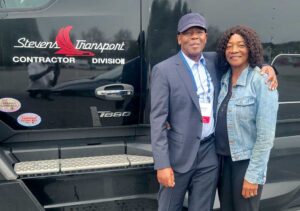When drivers are difficult to come by, many carriers refer to their cultures in their advertising efforts. They want prospective drivers to know that they’ll find a working environment in which they can thrive, as a part of a team that cares.
At Mondovi, Wisconsin-based Marten Transport, culture is not just a byword: It’s the backbone of the business.
“It’s our overall culture from the top down — doing the right things and making sure people have the right tools to do their job right,” explained Marten President Douglas Petit. “There are really no egos around here. We all work together. We all want what’s best for Marten Transport and for our drivers.”
Founded by Roger Marten in 1946 with a single milk truck, Marten Transport has since grown into a $1.2 billion, 3,400 truck diversified operation hauling refrigerated, dry van, and intermodal cargoes in the lower 48, Canada and Mexico. The company went public in 1986 and is listed on NADAQ as MRTN.
Marten offers drivers a $70,000 pay guarantee, but it’s the treatment that drivers receive that helps keep the company’s turnover rate much lower than the industry average. More than 400 Marten drivers have achieved a million miles of driving with the company.
“We really work as a team,” remarked Senior Vice President of Maintenance David Meyer, adding that one of the first things he noticed when he arrived in the Operations Department at Marten in 1998 was that individual departments had not “siloed,” as often occurs at the business world. Meyer was moved to Maintenance in 2009 with a mission to make sure Operations and Maintenance worked as a team to best serve Marten’s drivers.
“All departments have an operational sense of urgency,” Meyer continued. “You know, nobody just sits back. Everybody, at high levels and lower levels, understands what a tough life it is to be a driver. It’s a very difficult job, and we’re here to support as best we can.”
That’s important, said President of Operations-East Bruce Platter.
“Having the relationship he and I have, if he needs something done, he calls me and it’s done,” Platter explained. “We do that back and forth. The relationship we have with all of our departments is excellent.”
Haulers of refrigerated freight are well aware of the delays, requirements for driver labor, and other issues that can occur with some customers.
“They’re definitely an issue right now, with the lack of people working,” Platter noted. “We call those ‘black holes.’ When we find a black hole, we eliminate it, and we get after diversifying our customer base. That’s a huge thing for retention.”
Meyer pointed out another benefit of the culture of driver support.
“Our average over-the-road downtime is anywhere from .03% to .04%,” he remarked. “That’s important for driver retention. We figure out ways to make the driver experience better. Our (equipment) spec process, maintenance process, and road service group work together to maintain operational discipline.”
An important part of the company’s culture is that outside vendors are rarely used for maintenance.
“When I came in, in 2009 one of the first things I did was I turned everything in-house,” Meyer explained. “We try to do everything in-house because we have more control over costs and downtime. Both are key in top-line and bottom-line revenue.”
Some vendors are used when necessary to service dedicated or regional equipment that can be difficult to route to a company maintenance facility, he acknowledged. For most, however, company locations handle the PMs, requiring careful communication with operations to make sure drivers are routed to terminals on-time.
It’s not just PMs, however.
“Because of our extended drain intervals, we require the driver to get to an inspection lane between PMs,” Meyer emphasized. “It’s a quick inspection — 30 to 40 minutes — and the driver is required. We’re doing about 600 tractors and 700 trailers a week. We do this as a preventative measure so that guys aren’t broken down over the road. Our operational group is outstanding at executing services. It takes teamwork to accomplish this.”
Fuel expense is a concern for everyone — and once again, inter-departmental relationships help the team manage the costs.
“We’re running diesel-powered APUs. We know immediately if the APU is not working,” said Platter, adding that trip idle, currently running at about 2%, is monitored closely. “It’s very granular in the fleet manager space. They attack it weekly. They’re having conversations with the driver and they’re asking for a response by the end of the day.”
When increased idle is due to a problem APU, it gets fixed, fast.
The leadership group at Marten is quick to credit the company’s IT department for the systems that enhance inter-department communications. Marten runs a proprietary transportation management software system that was developed in-house; programs for maintenance and driver recruiting have been written in.
“Our IT department can make changes to it to make it better for drivers, fleet management people, and customer service,” Platter said.
Meyer agreed: “If I put in a request for outsourced software system or whatever it could be, it could be six months before they have time to do it. But if we need it quickly, it can be done in two days. That’s what separates our systems from others.”
Quick response from IT helped Marten develop its regional network, which, in turn, helps provide an increased number of opportunities for drivers who require more time at home than the OTR fleet provides. Incorporating intermodal accounts also required programming tweaks.
While the culture at Marten strives to provide an environment in which drivers want to stay, the process begins with hiring the right people. The company does not operate its own CDL school and does not have a driver finishing program for graduates of other schools.
“We hire experienced drivers only, and only those with clean safety records,” said Platter. “We try not to hire our turnover.”
Marten’s driver recruiting and operations departments communicate frequently on the status of drivers hired.
“Our recruiters follow up with fleet managers to see how their drivers are doing,” Platter continued.
“We have one of the safest fleets out there, and part of that is our hiring process,” Meyer said. “Marten tractors are equipped with collision-mitigation systems and lane departure, and by next year the fleet will be completely outfitted with blind-spot radar. And then, we have forward-facing cameras. Also, any new tractors come with a full set of disc brakes.”
Marten works to give back to the community by funding projects such as the Roger Marten Community Center in Mondovi and sponsored rooms at the Mayo Clinic in Rochester, Minnesota. The company offers scholarships for children of its employees, and contributes to a long list of charitable and civic causes.
Change is a constant in the trucking industry, but Marten Transport’s commitment to a culture that supports and satisfies its drivers isn’t likely to be among those changes.
Cliff Abbott is an experienced commercial vehicle driver and owner-operator who still holds a CDL in his home state of Alabama. In nearly 40 years in trucking, he’s been an instructor and trainer and has managed safety and recruiting operations for several carriers. Having never lost his love of the road, Cliff has written a book and hundreds of songs and has been writing for The Trucker for more than a decade.














